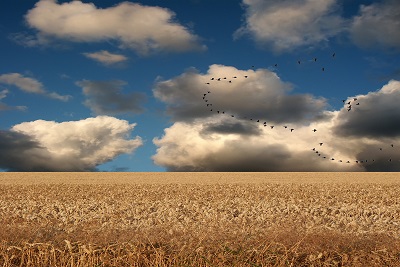
The Value of Birds
Birds are present throughout almost every habitat across the globe. No matter where you go, there is always evidence of birds even if you don't see the animals themselves. Things like holes pecked in tree bark by woodpeckers or the remnants of a nest are indicative of the presence of birds. While such marks left behind by these animals may seem insignificant, in many cases the activities of birds can have large consequences for the ecosystems they inhabit, making them incredibly important in the overall functioning of various ecosystems.
By contributing in such an important way to ecosystem health, birds can provide a number of direct benefits to humans. The Millennium Ecosystem Assessment, a study initiated by the United Nations, coined the term “ecosystem services” to describe these kinds of services.1 According to this panel, ecosystem services fall into four broadly defined categories and as we survey the diversity of birds across the globe, we find many ways in which the activities of birds provide services in each one of these.
Supporting Services
Actions within this category are those that are required for all other ecosystem services to be produced, such as nutrient cycling and the formation of soil.1 This category can be thought of as a foundation of processes without which other ecosystem services could not be produced.
Birds can help in these services by nutrient cycling, which has been documented in many habitats. By spreading activities through different habitats, birds can move nutrients from one place to another, which is particularly relevant in places where plant growth is limited by nutrient availability. A study on the islands in the Gulf of California showed that when birds roosted on them, the guano deposits they left behind provided nutrients to plants on the island 2. As a result, islands with seabirds had plants that grew taller and faster and were much more productive than those on islands without birds. Because the quality of these plants impacts the number of consumers and the structure of the food web, these birds exerted a bottom-up effect on the food web by regulating primary productivity.
This example is also interesting from an ecological standpoint because it exemplifies the intricate ways in which seemingly disparate habitats are connected and can impact one another. The primary productivity in the ocean regulates the number of fish it can support, which then impacts the number of birds that can feed on these fish, which then influences how many birds will roost on the island and leave guano deposits, ultimately dictating the primary productivity and food web structure on the island. Barry Commoner, one of the founders of the environmental movement, laid out four laws of ecology in his 1971 book The Closing Circle. One of these is “Everything is connected to everything else,” a premise we see clearly demonstrated in this example as birds serve as a vector for nutrients between aquatic and terrestrial habitats.
Birds are also capable of stimulating primary productivity in other ways, which supports the functioning of ecosystems, an example exhibited by birds in salt marshes. In Alaska, lesser snow geese and Canada snow geese stopover in salt marshes during spring migrations. While they are foraging in these marshes, they trample the ground, which tears up leaf litter and incorporates it into the soil. The smaller particle size and increased contact with the soil promotes greater decomposition, freeing nitrogen from the leaf litter and allowing it to cycle through the ecosystem.3
In the southeastern United States, cordgrass is the dominant plant in salt marshes. The salt marsh periwinkle is a major predator of cordgrass and in the absence of predation, these snails can overgraze the grasses and completely convert a productive marsh into mudflats.4 Predation of snails controls their numbers, which regulates primary productivity of salt marshes. Several species of birds such as oystercatchers, curlews, and plovers are predators of these snails and exert top-down population controls, which prevents overgrazing. In terms of the dollar value of services provided to humans, wetlands are considered one of the most valuable habitats, providing an array of important services like shoreline stabilization and water filtration.5 The presence of birds in these habitats ensures ecosystem functioning, allowing humans to gain the maximum benefit from these valuable ecosystems.
Provisioning Services
Many of the support services mentioned above can also be classified as provisioning services, our next category. Provisioning services encompasses products that we harvest from ecosystems and we can find many examples of activities in this category by examining how birds can positively impact the raising of crops and livestock.
A common traditional practice in the farming of rice straw in California was to burn the fields after harvest. However, this technique was banned in recent years to prevent air pollution and a widely used alternative is to flood fields instead. These flooded fields create habitat that is used for foraging by waterfowl. As these birds dive down to where the layer of straw rests on the ground, they tear, shred, and churn up the pieces of straw looking for grain and invertebrates. Such activities allow for greater contact of the soil with straw, increasing microbial decomposition. An experimental study in which waterfowl were permitted into areas of a flooded field and excluded from others showed that when the birds were present, there was a smaller biomass of straw, as well as lower nutrient concentrations.6 This study indicated the waterfowl presence successfully led to increased decomposition of straw in the field, which could prevent the need for autumn tillage, saving growers a substantial amount of money.
 In agricultural systems, birds can also be beneficial through the regulation of pests. In Guatemalan coffee plantations with higher abundances of insectivorous birds, there were fewer insects which resulted in less herbivorous damage to the leaves of crops.7 Experiments in Jamaica showed that the presence of birds led to a decrease in insect pests and increased the amount of saleable crops, leading to an increase in farm profits of up to $310 per hectare per year.8 Similarly, the construction of nest boxes for great tits in apple orchards has been shown to lead to greater numbers of birds in the area, which forage on caterpillars that can cause damage to crops, resulting in significantly higher crop yields.9 If installed and maintained properly, the construction of bird nest boxes can eliminate the need for pesticides, saving farmers money and preventing potentially dangerous chemicals from being applied. Similarly, the use of artificial perches for raptors around agricultural fields may increase the number of raptors that prey on rodents that can cause damage to crops.10
In agricultural systems, birds can also be beneficial through the regulation of pests. In Guatemalan coffee plantations with higher abundances of insectivorous birds, there were fewer insects which resulted in less herbivorous damage to the leaves of crops.7 Experiments in Jamaica showed that the presence of birds led to a decrease in insect pests and increased the amount of saleable crops, leading to an increase in farm profits of up to $310 per hectare per year.8 Similarly, the construction of nest boxes for great tits in apple orchards has been shown to lead to greater numbers of birds in the area, which forage on caterpillars that can cause damage to crops, resulting in significantly higher crop yields.9 If installed and maintained properly, the construction of bird nest boxes can eliminate the need for pesticides, saving farmers money and preventing potentially dangerous chemicals from being applied. Similarly, the use of artificial perches for raptors around agricultural fields may increase the number of raptors that prey on rodents that can cause damage to crops.10
Mutualistic relationships between birds and livestock can also be beneficial to humans. Many birds perch on livestock like cattle and forage on insects that live on them. Cattle egrets are particularly well known for making a living this way, and although they are native to Africa, their range has expanded dramatically concurrent with increases in the clearing of land for farming.11 While the birds benefit from a readily available food source, the animals on which they forage benefit from the removal of harmful parasites. In many parts of the world, people rely on cows for food and for milk. When infested with ticks, cows can become anemic and milk production flags. In Pakistan, birds are capable of effectively preying on these parasites, leading to healthier and more productive cows.12 This predation by birds is even more effective than pesticides in some cases. Through these interactions, humans gain a benefit by not spending money on expensive pesticides and by having more productive and healthier livestock.
Regulating Services
In this category, we group the benefits that are gained from the regulation of ecosystem processes. This includes services such as carbon sequestration, waste decomposition, and air purification. As with the other categories, there is no shortage of bird contributions to services in this arena.
Birds are important scavengers in many ecosystems, removing the carcasses of dead animals. While vultures are probably the best known for this, many types of birds opportunistically scavenge on this food source when it is available. In the Serengeti of Africa, vultures are capable of consuming hundreds of pounds of dead meat per kilometer annually and in Yemen, vultures can remove up to 25% of the organic waste produced in towns by humans.13, 14 Scavenging by birds is an important mechanism of waste disposal in many areas and prevents the outbreak of diseases than can occur through the accumulation of animal carcasses. In India, declines in vultures led to increases in feral dogs as there was less competition for carrion as a food source. The explosion of the dog population led to increases in rabies outbreaks and human injuries from dog attacks. The total estimated health cost of vulture declines between 1993 and 2006 is a whopping $34 billion.15 It is obvious in this case that the value of birds to humans can be quite high and underscores the direct importance of healthy birds populations to humans.
Another way that birds can provide regulating services is through promoting forest growth. This is important to humans because forests can sequester carbon and prevent it from going into the atmosphere where it would contribute to climate change. Birds are able to perform this role through dispersing plant seeds during foraging. When they pick a seed or fruit from a plant and fly off with it, they end up transporting the seed to another place where it can germinate. This behavior is a major mechanism for seed dispersal in many plants and can increase the genetic diversity of plants in a particular area by spreading seeds. In some cases, animals can carry seeds more than 40 meters away from the source tree.16
By germinating the seeds of trees, birds can contribute to the reforesting of deforested lands, diminishing the costs of restoration.17 In oak forests in Sweden, the cost of replacing the seed dispersal services of Eurasian jays in oak regeneration is an estimated $9,400 per hectare.18 Birds provide a valuable service in the expansion of forests, which sequester carbon and perform a number of other services that stand to benefit humans.
Cultural Services
The last category is cultural services and is a bit different from the others because it more abstract and includes less material benefits. As opposed to more tangible things like crop yields or water purification, services within the cultural category include things such as spiritual enrichment and the appreciation of nature.
An example of a service in this category is bird watching, which can be used as to foster ecotourism as a source of income. Many nature centers and nonprofit environmental organizations create revenue through taking visitors on bird watching tours. These kinds of activities can also be used to introduce students and children to the outdoors in order to foster an appreciation for nature. Similarly, zoos often acquire rare birds and then use them as a heavily marketed feature attraction to increase traffic and visitor revenue.
 Birds also serve a number of cultural roles and factor heavily into religions across the globe. For example, eagles are considered sacred messengers that carry prayers to the spiritual world in many Native American religions. Eagle feathers are believed to have holy powers and capturing eagles to remove the feathers is part of a sacred ritual.19 In many religions, vultures are considered deities that play a large part in their mythology and traditions.20 While it is difficult to place a dollar value on services within the cultural category, they are just as important because the spiritual enrichment and appreciation of nature that birds provide is an essential part of the human experience.
Birds also serve a number of cultural roles and factor heavily into religions across the globe. For example, eagles are considered sacred messengers that carry prayers to the spiritual world in many Native American religions. Eagle feathers are believed to have holy powers and capturing eagles to remove the feathers is part of a sacred ritual.19 In many religions, vultures are considered deities that play a large part in their mythology and traditions.20 While it is difficult to place a dollar value on services within the cultural category, they are just as important because the spiritual enrichment and appreciation of nature that birds provide is an essential part of the human experience.
Summary
In this review, we have taken an ecological approach by focusing on ways that birds provide services to humans through their interactions with the environment. However, it should also be noted that the direct take of birds and their products also provides economic benefit in many cases. Cultures across the world hunt birds and eggs for subsistence and to make a living. In Malaysia, the nests of swiftlets are harvested for their use in cooking. They are considered a delicacy and are an extremely valuable commodity, with a single nest of good quality having a value of more than $700 in some cases.21 Many cultures also harvest birds for uses in traditional medicine. In the cultural category, many people gain recreational benefit by hunting birds. In cases where this hunting is regulated, the sale of permits raises money that is used to fund governmental agencies and services.
Because birds are so common in most habitats, we often overlook their ecological significance. However, their ecological roles are incredibly important and humans can benefit monetarily through the many actions of birds. The examples described above are just a few of the many ways that birds provide ecosystem services. Quantifying the monetary benefit from birds around the world is nearly impossible, but likely numbers in the billions of dollars annually. The value we gain from birds warrants a serious investigation into causes of declines and provides additional rationale for the continued study and conservation of these animals.
Sources
- Millennium Ecosystem Assessment Findings. 2005: Millennium Ecosystem Assessment.
- Anderson, W.B. and G.A. Polis, Nutrient fluxes from water to land: seabirds affect plant nutrient status on Gulf of California islands. Oecologia, 1999. 118(3): p. 324-332.
- Zacheis, A., R.W. Ruess, and J.W. Hupp, Nitrogen dynamics in an Alaskan salt marsh following spring use by geese. Oecologia, 2002. 130(4): p. 600-608.
- Silliman, B.R. and M.D. Bertness, A trophic cascade regulates salt marsh primary production. Proceedings of the national Academy of Sciences, 2002. 99(16): p. 10500-10505.
- Costanza, R., et al., The value of New Jersey's ecosystem services and natural capital. 2006.
- Bird, J., G. Pettygrove, and J. Eadie, The impact of waterfowl foraging on the decomposition of rice straw: mutual benefits for rice growers and waterfowl. Journal of Applied Ecology, 2000. 37(5): p. 728-741.
- Greenberg, R., et al., The impact of avian insectivory on arthropods and leaf damage in some Guatemalan coffee plantations. Ecology, 2000. 81(6): p. 1750-1755.
- Johnson, M., J. Kellermann, and A. Stercho, Pest reduction services by birds in shade and sun coffee in Jamaica. Animal Conservation, 2010. 13(2): p. 140-147.
- Mols, C.M. and M.E. Visser, Great tits can reduce caterpillar damage in apple orchards. Journal of Applied Ecology, 2002. 39(6): p. 888-899.
- Kay, B., et al., The use of artifical perches to increase predation on house mice (Mus domesticus) by raptors. Wildlife Research. 21(1): p. 95-105.
- Burnie, D., Bird: The Definitive Visual Guide. 2007, Great Britain: Doring Kindersley Limited.
- Perveen, F., et al., Ixodid ticks infestation in livestock and their traditional control in N-WFP, Pakistan. Pakistan Journal of Entomology Karachi, 2010. 25(1): p. 43.
- Prakash, V., et al., Catastrophic collapse of Indian white-backed (Gyps bengalensis) and long-billed (Gyps indicus) vulture populations. Biological conservation, 2003. 109(3): p. 381-390.
- Gangoso, L., et al., Reinventing mutualism between humans and wild fauna: insights from vultures as ecosystem services providers. Conservation Letters, 2013. 6(3): p. 172-179.
- Markandya, A., et al., Counting the cost of vulture decline-An appraisal of the human health and other benefits of vultures in India. Ecological Economics, 2008. 67(2): p. 194-204.
- Godoy, J.A. and P. Jordano, Seed dispersal by animals: exact identification of source trees with endocarp DNA microsatellites. Molecular Ecology, 2001. 10(9): p. 2275-2283.
- Wunderle Jr, J.M., The role of animal seed dispersal in accelerating native forest regeneration on degraded tropical lands. Forest Ecology and Management, 1997. 99(1-2): p. 223-235.
- Hougner, C., J. Colding, and T. Söderqvist, Economic valuation of a seed dispersal service in the Stockholm National Urban Park, Sweden. Ecological Economics, 2006. 59(3): p. 364-374.
- De Meo, A.M., Access to eagles and eagle parts: Environmental protection v. native American free exercise of religion. Hastings Const. LQ, 1994. 22: p. 771.
- Benson, E.P., The Vulture: The Sky and the Earth. Palenque Round Tables, 1996. 10: p. 309-319.
- Whelan, C.J., D.G. Wenny, and R.J. Marquis, Ecosystem services provided by birds. Annals of the New York Academy of Sciences, 2008. 1134(1): p. 25-60.
- Invasive Species: How They Affect the Environment - February 23, 2015
- Birds in a Changing Climate - February 11, 2015
- Environmental Consequences of Fishing Practices - February 6, 2015
Related Articles
Featured Article

Gaining International Experience in Environmental Science





